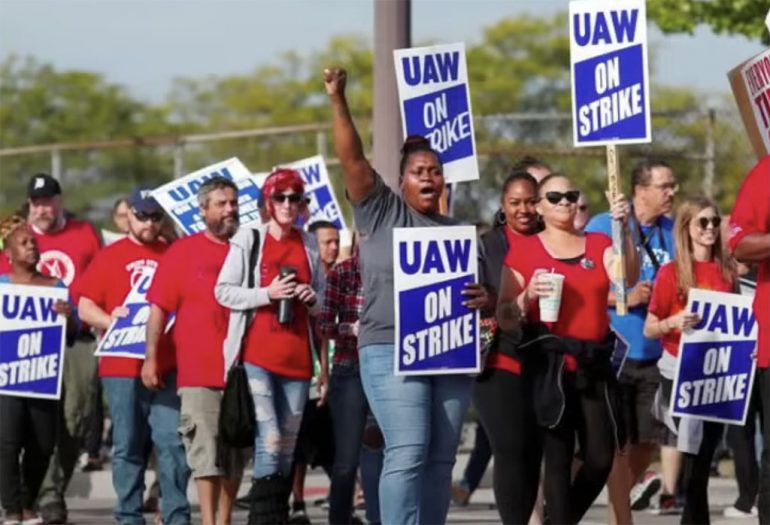
On a fateful Friday, the United Auto Workers (UAW) union embarked on a landmark labor action, initiating simultaneous strikes at three prominent auto manufacturing plants owned by General Motors, Ford, and Stellantis, the parent company of Chrysler, in what marked the most significant industrial labor movement in the United States in decades.
The collective action unfolded at factories in the Detroit area and brought production of some of the most popular and profitable vehicles in the nation to an abrupt halt. The strike’s ripple effects would be felt across the automotive industry and beyond.
UAW President Shawn Fain announced the bold move, declaring, “For the first time in our history, we will strike all three of the Big Three.” While initially opting for targeted strikes, Fain left no doubt that more extensive company-wide strikes remained a possibility if new contracts were not reached.
The labor dispute had been simmering for weeks, marked by clashes between Fain and top executives at the Detroit automakers. The primary issues at stake were the union’s demands for a more substantial share of the profits generated by traditional combustion trucks and greater job security in the face of the industry’s pivot towards electric vehicles. The standoff took on a political dimension, with President Joe Biden, facing re-election, urging both sides to find common ground.
The strikes involved a combined workforce of 12,700 employees and impacted assembly plants operated by Ford in Wayne, Michigan, GM in Wentzville, Missouri, and Stellantis’ Jeep brand in Toledo, Ohio. These plants were critical to the production of some of the automakers’ most lucrative models.
Fain’s strategy of targeted walkouts was intended to minimize the financial burden on the union, as the UAW’s strike fund of $825 million paled in comparison to the substantial liquidity amassed by the automakers due to robust profits from trucks and SUVs produced by UAW members. Stellantis, in particular, had a significant buffer, with over 90 days’ worth of Jeeps in stock. However, even a week-long shutdown at the Jeep plant in Toledo could result in a revenue loss of over $380 million.
Some industry experts viewed the initial strike as more symbolic than genuinely damaging. Sam Fiorani, a production forecaster at Auto Forecast Solutions, estimated that the limited action would disrupt the production of approximately 24,000 vehicles per week. While targeting key brands, consumers were willing to wait—for now.
As the strike commenced in Wayne, Michigan, hundreds of workers and their supporters gathered at a Ford assembly plant, underscoring the significance of the labor movement.
Financial markets responded to the news, with Stellantis shares dropping over 1%, while Ford and GM shares declined 2.3% and 1.7%, respectively, in early premarket trading in New York.
The heart of the dispute centered on compensation, with the UAW demanding a 40% wage increase. In contrast, the companies offered up to 20%, albeit without some key benefits sought by the union. Furthermore, none of the Detroit automakers proposed eliminating tiered wage systems that required new hires to wait eight years to earn the same as veteran workers.
Ford argued that the UAW’s latest proposals would double its U.S. labor costs, making it less competitive against non-union rivals like Tesla. They cautioned that a prolonged strike could severely impact UAW profit-sharing checks for the year.
Stellantis went into “contingency mode” to protect its North American operations, hinting at potential facility closures. GM expressed disappointment with the strike but pledged to continue bargaining.
The ramifications extended beyond the automakers themselves. Suppliers and industries reliant on the automotive sector faced the prospect of dwindling demand and financial strain should the UAW’s strike force Detroit Three’s U.S. manufacturing operations to a halt.
Meanwhile, President Biden’s efforts to subsidize electric vehicle sales collided with the UAW’s concerns about the impact on traditional combustion powertrain jobs. The union had not yet endorsed Biden’s re-election, highlighting the complexities of the situation.
UAW President Fain’s unconventional approach to negotiations, bargaining simultaneously with all three Detroit automakers, had set a unique tone for this labor dispute. Past UAW leaders typically selected one company to set the contract pattern for the others. Fain, on the other hand, sought to leverage competition among the companies to secure better offers.
While the possibility of a resolution remained, the strike presented an opportunity for non-union automakers in the United States, including Tesla, Toyota, Honda, and Mercedes. These non-union factories and imported vehicles constituted more than half of the U.S. market, offering them a potential advantage during the turmoil.
As the strike commenced, analysts estimated that each affected automaker could incur earnings losses of $400 million to $500 million per week of lost production, with diminishing prospects of recouping those losses as the strike dragged on. The implications were far-reaching, affecting workers, companies, and the broader U.S. automotive landscape.

Mike Floyd is a finance executive by trade and a car enthusiast at heart. As a CFO with a keen eye for detail and strategy, Mike brings his analytical mindset to the automotive world, uncovering fresh insights and unique perspectives that go beyond the surface. His passion for cars—especially his favorite, the Porsche 911, fuels his contributions to Automotive Addicts, where he blends a love for performance and design with his professional precision. Whether he’s breaking down industry trends or spotlighting emerging innovations, Mike helps keep the site both sharp and forward-thinking.